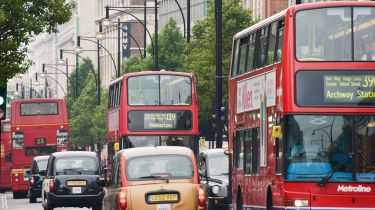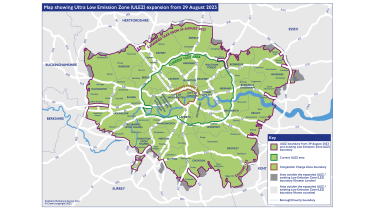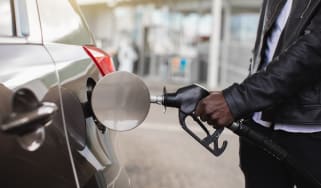London ULEZ: Ultra Low Emissions Zone expansion, charges and map
The ULEZ has now expanded to cover all London boroughs. Here are the facts about the charge, the zone map and the cars affected

When you next drive into London, keep a beady eye on where you’ll be travelling – because there’s a fair chance you’ll be driving through the expanded London Ultra Low Emission Zone (ULEZ). If you enter the ULEZ zone and your car doesn’t meet the current emissions standards you will be subject to the £12.50 daily ULEZ charge.
Implemented in April 2019, the ULEZ made a big impact, initially covering the same geographical area as the London Congestion Charge Zone, then expanding in 2021 to the area inside the north and south circular roads. Then, on 29 August 2023 – despite legal challenges from some local councils – the ULEZ expanded further to cover most of Greater London, up to the city’s borders with Buckinghamshire, Essex, Hertfordshire, Kent, and Surrey. The expansion also includes Heathrow airport, affecting the hundreds of thousands of travellers who arrive at the airport by car each year.
The Ultra Low Emissions Zone sets exhaust emissions standards for vehicles driving within its boundaries and any cars or commercial vehicles failing to comply must pay a charge to enter. Owners of cars that do not meet the ULEZ emissions standards have to pay a daily charge of £12.50 to drive into the zone, which, unlike the Congestion Charge Zone, operates 24 hours a day, 365 days a year.
The ULEZ was introduced in London primarily to cut emissions of nitrous oxides and particulates in the city with the aim of improving air quality. The Mayor of London is running a scrappage scheme to make the switch to cleaner vehicles more affordable for certain groups.
To find out more about the ULEZ charge, the area it covers and which types of vehicle are affected, scroll down for our complete London Ultra Low Emissions Zone guide…
What is the ULEZ?
The Ultra Low Emissions Zone is an area of London where the most polluting vehicles must pay a levy in order to use the roads. The ULEZ charge initially replaced the previous T-Charge.
While at first the ULEZ covered the same area as the Congestion Charge Zone in central London, it was expanded in October 2021 to cover all areas inside the North and South Circular – and the zone expanded again to cover the entirety of Greater London on 29 August 2023.
How much is the ULEZ charge?
The ULEZ charge, which must be paid on top of the £15 daily Congestion Charge in central London, is set at a standard rate of £12.50 – although this varies depending on the vehicle. The charge is in effect 24 hours a day, seven days a week.
The ULEZ charge and the Congestion Charge in combination bring the total cost for some vehicles entering central London between 7am and 10pm on weekdays up to £27.50.
Which vehicles are affected by the ULEZ?
Generally speaking, the ULEZ affects pre-Euro 6 diesels – those built before around 2016 – and pre-Euro 4 petrols, which broadly covers those built prior to 2006. Some petrol models that meet the Euro 4 standards were available from 2001 onwards, however.
In cases where a car is compliant but not recognised as such by Transport for London (TfL), the onus is on its owner to provide paperwork documenting its Euro standard – known as a Certificate of Conformity – in order for the car to be given an individual exemption from the charge. You can typically apply to your car’s manufacturer for a copy of the certificate if you don’t currently have a copy. If you don’t register your vehicle with TfL you risk being fined for entering the zone without paying the daily charge.
As well as non-Euro 6 diesel cars and vans, and non-Euro 4 petrols, non-Euro 3 motorbikes are targeted. Historic vehicles – currently those built before 1983 – are exempt from the ULEZ, as long as they have been awarded historic vehicle tax status. Any vehicles constructed before 1st January 1973 are also exempt, regardless of commercial use or otherwise.
What are the penalties for entering the ULEZ without paying?
You can use the TfL checker tool to determine your vehicle’s emissions standard status. Affected drivers who forget to pay the £12.50 ULEZ charge will be fined £180, reduced to £90 if paid within 14 days.
Euro VI lorries, buses and coaches – essentially vehicles made before 2013 or 2014 – are also affected by the LEZ. They need to pay between £100 and £300 (depending upon the vehicle emission status) to enter the zone, with drivers fined £1,000 – reduced to £500 if paid within 14 days – for failing to pay.
The Latest data shows that nine out of 10 cars and 8 out of 10 vans seen driving in the zone on an average day are already compliant with the ULEZ restrictions.
ULEZ scrappage scheme
The Mayor of London, Sadiq Kahn, has launched a £110 million scrappage scheme to provide financial support for eligible Londoners to scrap their highest polluting vehicles in preparation for the expansion of the ULEZ zone in August.
The current scrappage scheme has provided financial assistance to couples and families earning up to £40,000 per year to scrap the most polluting vehicles, taking over 15,000 vehicles off London’s roads.
The latest updated scheme, with support available from July 2023, will now allow all families claiming child benefits to apply for assistance. Additionally, businesses with fewer than 50 employees can apply to receive support. This updated scheme will be kept under ongoing review by the Mayor’s office and Transport for London (TfL).
How to pay the ULEZ charge
There are various ways of paying the ULEZ charge. If you drive into the zone regularly in a vehicle that isn't exempt, you can register for the Auto Pay system with no registration or renewal fee. This covers the congestion charge but will be expanded to cover the ULEZ charge, too. You can find further details on the Auto Pay website.
You can make individual ULEZ payments online via the TFL website or through the TFL phone app. Finally, you can pay the ULEZ over the phone by calling 0343 222 2222.
ULEZ map
The map below shows the ULEZ zone expansion since 29 August 2023

What will the results of the ULEZ be?
The latest estimates from TfL suggest that 100,000 cars, 35,000 vans and 3,000 lorries currently pay the ULEZ charge each day, but has previously claimed that most of them will be “infrequent” visitors who only enter the zone about once a year.
TfL says ULEZ is especially beneficial to the young, older people and those who have respiratory problems, as well as residents of high pollution areas. Previous data from TfL suggested roughly 70 per cent of vehicles entering the zone were compliant.
A report from February 2023 showed that harmful nitrogen dioxide (NO2) levels are 46 per cent lower in central London and 21 per cent lower in inner London than they would have been without the ULEZ scheme. Since 2019, nitrogen oxides (NOx) emissions have reduced by 23 per cent (13,500 tonnes) across London cumulatively compared with what they would have been without the ULEZ.
Want your next car to be a low emissions vehicle, check out our best low emission green cars…
Find a car with the experts






